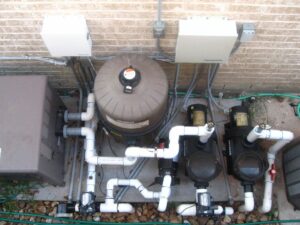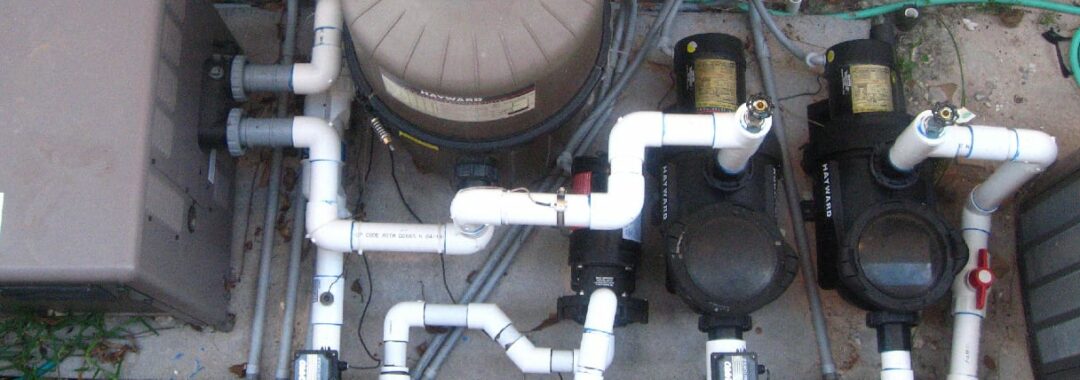In order to know how long to run your pool pump daily, you will need to be familiar with some pool equipment and know some specifics about your pool. Throughout this learning process you are going to become very close with your pool pump and filter systems.
 Do you know the purpose of your pool pump? It circulates the water to help distribute chemicals and then filter out certain matter from your water to keep your water clean and safe.
Do you know the purpose of your pool pump? It circulates the water to help distribute chemicals and then filter out certain matter from your water to keep your water clean and safe.
Not only does your pool pump and filter keep your pool in beautiful condition but, it can also add extensively to your electrical bill, so it becomes a love, hate relationship rather quickly. Your pump works hard to keep your water clean and safe every day, so making sure you are running it efficiently is best. Minimizing your electrical bill and maximizing the lifetime of your pump. This is one of those parts of pool care that, if you get it wrong, can cost you quite a bit of money. The key is to understand your pool pump’s purpose, the type of pump you have (or could have), and how best to take advantage of its features.
So how can you get all the benefits without spending extra money on electrical costs you don’t need?
This can become very technical so I will do my best to try and keep it as simple as possible.
First, you will need to determine your pump’s flow rate and speed options. To determine this, read on!
Flow Rate
Your flow rate is how much water your pump filters in a set time period. That speed is your flow rate. (Note: This is not the same as a turnover rate.) You can also find the flow rate on the manufacturer’s instructions for your pool pump. It’ll be measured in gallons per minute (gpm) or gallons per hour (gph).

Pool pumps and speed-options
Now for determining the speed options on your pool pump. Typically there are two different types of pool pumps, a single-speed and a two-speed.
A single-speed pump has a single flow rate. This is. The simpler of the 2 pumps in that it has a timer to most of the work for you. So you don’t have to think about when to turn the speed up or down. However, the downside is you don’t have an option to run your pump at a lower speed to save energy.
A two-speed pump is a step up: you can flip a switch between a high speed and low speed. Lower speeds also means lower noise which is a nice benefit.
Next, we need to figure out the turnover rate. The turnover rate of a swimming pool is the amount of time it takes for the pumping and filtration systems to cycle all of the water in the pool one time around. A typical turnover rate for a pool is 8 hours or less.
Something to also keep in mind of is your pump will need to run longer and at higher speeds after you have had a large number of swimmers or if it is extra warm during the summer months. So, after your kid’s birthday party with their 12 friends, it’s a good time to run it extra and especially run it longer during those hot Florida months.
Follow this formula to find your turnover rate…
________________________________
Pool Volume (gallons of pool water)
We like to use this handy dandy online calculator called the Pool Volume Calculator by Penair.
÷
Flow Rate (gallons filtered per hour)
=
Total hours for one complete turnover
________________________________
The time of day you run your pump can be an important factor to keeping your costs down as well.
Run your pump during non-peak or night time hours. Did you know the rate you pay for electricity changes throughout the day? It’s based on what electric providers call peak hours, meaning when more people are using more power, and putting more strain on the grid.
Peak hours vary from location to location. For example, in warmer climates, peak hours most likely correlate to when people have their air-conditioning cranked, maybe late afternoon or early evening when people are getting home from work and turning up the A/C.
All it takes is a call to your provider to find out the peak hours where you live. Once you know that, try to schedule your pool pump run time around those hours to keep your cost lower.
Yes, you want to run your pool pump for at least eight hours every day to complete at least one turnover cycle. But that doesn’t mean it has to be eight hours straight.
Work around the non-peak hours and run your pump for three hours here, 1 hour there, and then four hours there. As long as it runs for at least 8 hours in every 24-hour period, you’re good to go.
Overall, the lessons learned today is you should run your pool pump an average 8 hours a day to properly circulate and clean your water. The pump should push your entire pool in gallons in this 8 hour period of time.
Residential pool water only needs to be turned over once daily to have proper filtration. The key to a properly sanitized pool is not only filtered water but also well-balanced water chemistry. If your water is unbalanced then issues will arise no matter how much the water churns. A good once through your filter system should alleviate you of troublesome bacteria barring some kind of major chemical imbalance.
